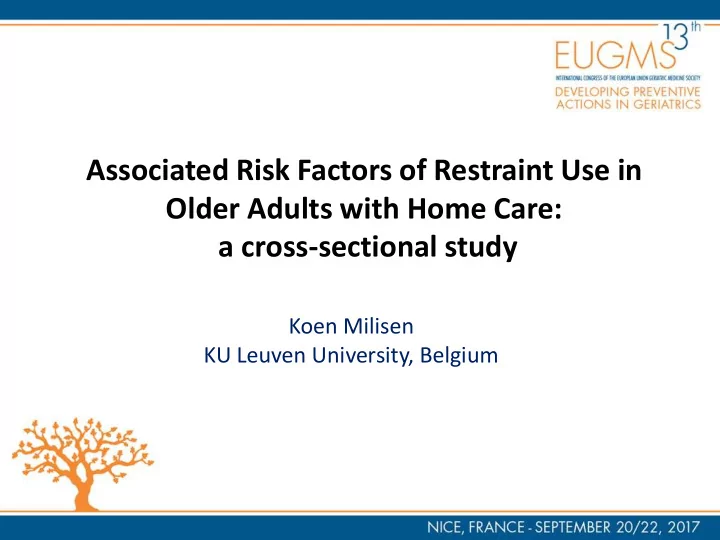

Associated Risk Factors of Restraint Use in Older Adults with Home Care: a cross-sectional study Koen Milisen KU Leuven University, Belgium
CONFLICT OF INTEREST DISCLOSURE I have no potential conflict of interest to report
Associated Risk Factors of Restraint Use in Older Adults with Home Care: a cross-sectional study Kristien Scheepmans, Koen Milisen, Koen Vanbrabant, Louis Paquay, Hendrik Van Gansbeke, Bernadette Dierckx de Casterlé EUGMS 2017 3
Background - Restraint use is common in home care - Prevalence ranging from 7% to 24.7% (de Veer et al., 2009, Beerens et al., 2016, Hamers et al., 2016, Kurata & Ojima, 2014, Scheepmans et al., 2014 & 2017) - Growing number of frail older persons living at home ↑ risk for restraint use - More healthcare workers confronted with increased demand for restraint use in home care EUGMS 2017 4
Background - Research on factors associated with restraint use in home care is scarce - Specificity of home care setting requires more insights in the associated factors of restraint use in home care EUGMS 2017 5
AIM - To gain insight into the factors associated with restraints on older adults receiving home care EUGMS 2017 6
Methods - Design: Cross-sectional survey - Setting and sample - 8000 subjects randomly selected from a total of 45,700 older adults (60 years or older), receiving home care from a nursing organization in Belgium - Data from 6397 subjects could be used for further analysis EUGMS 2017 7
Methods - Measurements - For each patient, the primary nurse completed a validated questionnaire collecting information about patient related factors - non-patient related factors - - restraint use (primary outcome) - Observations during the “past four weeks” EUGMS 2017 8
Methods - Patient related factors (such as) : - Age - Gender - ADL dependency - History of falls - Nurses ’ perceived risk of falling - Cognitive decline - Polypharmacy - Behavioral problems - … EUGMS 2017 9
Methods - Non-patient related factors (such as) : - Presence of supervision - Presence of informal caregiver - Informal caregiver’s well -being and perceived support - … EUGMS 2017 10
Methods - Restraint use (absent or present) : “Any actions performed by healthcare workers and/or relatives that restricted the patient’s freedom to some extent” (Scheepmans et al., 2014, 2017) EUGMS 2017 11
Methods - Analysis - Binary logistic regression model with generalized estimating equations - Missing data: multivariate imputation using the fully conditional specification approach EUGMS 2017 12
Results - Sample characteristics (n = 6397) - 66.8% female - mean age of 80.6 years (SD= ± 7.8) - 29.5% with cognitive decline (Cognitive Performance Scale) - 30.3% with a fall history in previous six months - 58.4 % “perceived” by nurses as at risk of falling - completely dependent for bathing (42.4%) or dressing (40.1%) - 6.4% with behavioral problems EUGMS 2017 13
Results - Sample characteristics - 46.4% lived alone - 76.3% were supervised - 70.0% had an informal caregiver - 17.7% expressed feelings of sadness, anger or depression EUGMS 2017 14
Results Prevalence of restraint use ‐ 24.7% (CI= 95%; 23.6-25.7%) ‐ Most common types of restraints ‐ Bed against the wall (39,0%) ‐ Adaptation of the house (25.8%) ‐ Bedrails (24.1%) ‐ The least common types of restraints ‐ Locking the room (2.4%) ‐ Restraint vest (0.8% ‐ Nursing blanket (0.2%) ‐ Ankle and wrist ties (0.7%) ‐ Sleeping bag (0.7%) ‐ EUGMS 2017 15
Results (multivariate model) - Associated factors: patient related - ADL-activities eating (OR= 2.181, 95% CI= 1.212 – 3.925) transfer (OR= 2.131, 95% CI= 1.191 – 3.812) continence (OR= 1.436, 95% CI= 0.925 – 2.231) - Nurses ’ clinical judgement of risk of falling (OR= 1.994, 95% CI= 1.710 – 2.324) - Behavioral problems (OR= 1.446, 95% CI= 1.048 – 1.995) - Cognitive impairment (OR= 1.398, 95% CI= 1.290 – 1.515) - Polypharmacy (OR= 1.415, 95% CI= 1.219 – 1.641) EUGMS 2017 16
Results (multivariate model) - Associated factors: non-patient related - Supervision (OR= 2.433, 95% CI= 1.948 3.038) - Informal caregiver’s well-being such as feelings of sadness, anger, depression (OR= 1.472, 95% CI= 1.126 1.925) - Informal caregiver’s dissatisfaction with family support (OR= 1.339, 95% CI= 1.003 1.788) EUGMS 2017 17
Conclusions ‐ Both patient and non-patient factors are associated with restraint use ‐ Patient-related ‐ = characteristics of “frail older adults” (e.g. cognitive decline, poor mobility) ‐ factors comparable to associated factors found in nursing homes ‐ Nurses’ clinical judgement of risk of falling !! ‐ = worrisome, given that restraint use is not a good way of preventing falls EUGMS 2017 18
Conclusions ‐ Non-patient related factors such as well-being of the informal caregiver and dissatisfaction with family support ‐ Specific factors only found in home care setting ‐ Indicates high burden placed on informal caregivers ‐ Necessity to develop interventions to support informal caregivers; and as a consequence to reduce restraints in home care EUGMS 2017 19
Thank you!
Recommend
More recommend